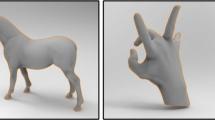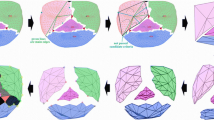Abstract
Subdivision surfaces (SubD, NURSS) construction is a popular method to present and animate sculpture shapes for entertainment, and this is preferred due to advantage of polygon mesh. But subdivision surfaces have limited familiarity and portability in modern CAD, unlike NURBS-based entities. NURBS-based sculpting using dense point cloud data obtained through geometric subdivision has been so far a less discussed topic. The current work discusses the new methodology of using geometric subdivision and NURBS interpolation with an aim to add a new dimension to reverse engineering. This has distinct advantages like accurate shape building using scanned data, manufacturing ability of complex shapes, faster and accurate shape representation with high quality surfaces, model portability, and a better control on object shape and better patch-planning. Major milestones of the work are bridging the geometric subdivision and NURBS reconstruction on subdivided data, NURBS patch and topology planning (straight and PDPA scan), construction of trimmed NURBS surfaces and, finally, writing IGES of resultant patches. The work is a high-level automation solution for complex constructions. It is applied on human head-scan data and results are displayed.
Similar content being viewed by others
References
Benkö P, Martin RR, Várady T (2001) Algorithms for reverse engineering boundary representation models. Elsevier Comp Aided Des 33(11):839–851
Benkö P, Kós G, Várady T, Andor L, Martin RR (2002) Constrained fitting in reverse engineering. Elsevier Comput Aided Geom Des 19:173–205
Blasi F, Monno G, Uva AE (2001) Implicit surfaces modeling for objects reconstruction from scattered 3D points clouds. Proc. of the XII ADM International Conference, Italy
Kruth JP, Kersterns A (1998) Reverse engineering modeling of free-form surface from point clouds subject to boundary condition. J Mater Process Technol 76(1–3):120–127
Ma W, Kruth JP (1998) NURBS curve and surface fitting for reverse engineering. Int J Adv Manuf Technol 14(12):918–927
Pal P (2001) An easy rapid prototyping technique with point cloud data. Rapid Prototyping J, MCB University Press 7(2):82–89
Pál B, Kós G, Várady T et al (2002) Constrained fitting in reverse engineering. Elsevier Comput Aided Geom Des 19(2):173–205
Robertson C, Fisher RB, Werghi N, Ashbrook AP (2000) Fitting of constrained feature models to poor 3D data. Proc. Adaptive Computing in Design and Manufacture (ACDM 2000), Plymouth, UK, pp 149–160
Sun W, Bradley C, Zhang YF, Loh HT (2001) Cloud data modeling employing a unified non-redundant triangular mesh. Elsevier Comp Aided Des 33(2):183–193
Tai C, Huang M (2000) The processing of data points basing on design intent in reverse engineering. Elsevier Journal of Machine Tools and Manufacture 40:1913–1927
Wang X-b, Li S-y (2001) Automatic calculation of initial weights for NURBS. Acta Aeronautica et astronautica Sinica 22(2):184–189
Werghi N, Fisher RB, Robertson C (2001) Constrained object reconstruction incorporating free-form surfaces. Proc. IX Spanish Symposium on Pattern Recognition and Image Analysis, Benicàssim, Spain, pp 273–280
Yang X (2005) Surface interpolation of meshes by geometric subdivisions. Elsevier Comp Aided Des 37(5):497–508
Yin Z, Jiang S (2003) Automatic segmentation and approximation of digitized points for reverse engineering. Int J Prod Res 41(13):3045–3058
Zhou RR, Zhang LY, Su X, Zhou LS (2001) Research on the algorithm of surface reconstruction from dense scattered points. Chinese Journal of Software 13(2):249–255
Catmull E, Clark J (1978) Recursively generated B-spline surfaces on arbitrary topological meshes. Comput Aided Des 10(6):350–355
Doo D, Sabin M (1978) Analysis of the behavior of recursive division surfaces near extraordinary points. Comput Aided Des 10(6):356–360
Ball AA, Storry DJT (1988) Conditions for tangent plane continuity over recursively generated B-spline surfaces. ACM Trans Graph 7(2):83–102
Peters J, Reif U (1997) Analysis of generalized B-spline subdivision algorithms. SIAM Journal of Numerical Analysis
Woo H, Kang E, Wang S, Lee KH (2002) A new segmentation method for point cloud data. Elsevier Int J Mach Tools Manuf 42:167–178
Jung HB, Kim K (2000) A new parameterization method for NURBS surface interpolation. Int J Adv Manuf Technol 16:784–790
Delaunay Triangulation - Wikipedia, the free web encyclopedia, web reference, http://en.wikipedia.org/wiki/Delaunay_triangulation
Point Cloud Data Sources (web) of Human Head, 1. ftp://ftp.research.microsoft.com/users/hhoppe/data/thesis/input_pts/ (mannequin.12772.pts) 2. http://pralay-pal.mycv.tv/head_scan_data.htm
Author information
Authors and Affiliations
Corresponding author
Rights and permissions
About this article
Cite this article
Pal, P. A reconstruction method using geometric subdivision and NURBS interpolation. Int J Adv Manuf Technol 38, 296–308 (2008). https://doi.org/10.1007/s00170-007-1102-0
Received:
Accepted:
Published:
Issue Date:
DOI: https://doi.org/10.1007/s00170-007-1102-0




